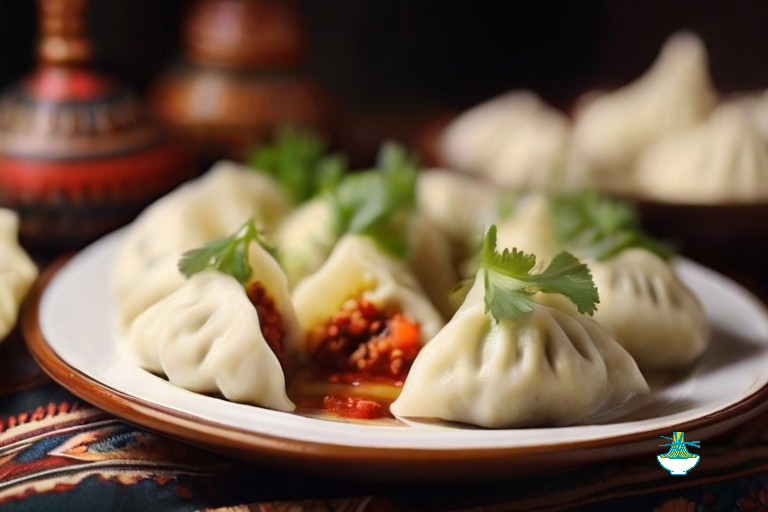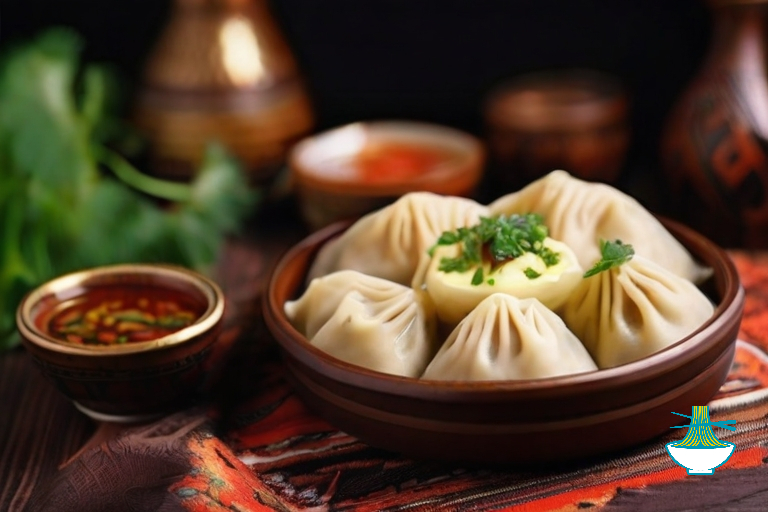Armenian Manti is more than a dish; it’s a celebration of flavor, history, and health. These bite-sized dumplings, filled with spiced meat or vegetables, combine wholesome ingredients that bring both taste and nutritional benefits. The meat filling provides high-quality protein, iron, and essential B vitamins, supporting energy and overall health. The inclusion of garlic or onions offers antioxidants like allicin, boosting immunity and heart health, while aromatic spices such as cumin and paprika add anti-inflammatory properties. Even the dough, often enriched with eggs, contributes to a balanced intake of nutrients. Armenian Manti embodies the perfect harmony of tradition and well-being in every bite.

Ingredients:
For the Dough:
- 2 cups all-purpose flour
- 1/2 teaspoon salt
- 1 large egg
- 1/2 cup water (adjust as needed)
For the Filling:
- 1 lb ground beef or lamb (or a combination)
- 1 large onion, finely chopped
- 2 cloves garlic, minced
- Salt and pepper to taste
For the Sauce:
- 1 cup plain yogurt
- 2 cloves garlic, minced
- 1 tablespoon olive oil
- Salt to taste
For Garnish:
- Fresh parsley, chopped
- Paprika (optional)
Instructions:
Prepare the Dough:
1- In a large mixing bowl, combine the flour and salt. Make a well in the center and add the egg.
2- Gradually incorporate water into the flour, kneading the dough until it becomes smooth and elastic. Cover and let it rest for about 30 minutes.
Prepare the Filling:
1- In a mixing bowl, combine the ground meat, chopped onion, minced garlic, salt, and pepper. Mix well until all ingredients are evenly distributed.
Shape the Manti:
1- Roll out the dough on a floured surface into a thin sheet.
2- Cut the sheet into small squares, approximately 2 inches by 2 inches.
3- Place a small amount of the meat filling in the center of each square.
4- Fold the squares into a triangle, sealing the edges by pressing them together.
Cook the Manti:
1- Bring a large pot of salted water to a boil.
2- Carefully add the Manti to the boiling water and cook until they float to the surface, indicating they are cooked through (about 10-15 minutes).
3- Remove the cooked Manti with a slotted spoon and set aside.
Prepare the Sauce:
1- In a separate bowl, mix together the plain yogurt, minced garlic, olive oil, and salt to taste. Adjust the consistency with a bit of water if needed.
Serve:
1- Arrange the boiled Manti on a serving platter.
2- Drizzle the yogurt sauce over the Manti.
3- Garnish with chopped fresh parsley and a sprinkle of paprika if desired.
Enjoy:
1- Serve the Armenian Manti warm and enjoy the delicious blend of flavors and textures.
This recipe captures the essence of traditional Armenian Manti, but keep in mind that variations exist across different regions and households. Adjustments can be made according to personal preferences.
Serving Suggestions
- To present Manti elegantly, layer it on a platter with yogurt sauce drizzled over the top.
- Add a sprinkle of paprika, fresh parsley, or a dollop of spiced butter for a restaurant-quality finish.
Frequently Asked Questions
1. What are the origins of Manti?
- Manti has a rich history that dates back to the Silk Road era. It is believed to have originated in Central Asia and spread across various cultures, including Armenian, Turkish, and Middle Eastern cuisines. Each culture has adapted the recipe, adding its unique touch. Armenian Manti, in particular, stands out for its distinctive triangular shape and yogurt-based sauce.
2. Are there vegetarian alternatives for Manti?
- Absolutely! Vegetarian Manti can be made using fillings such as spinach and feta, mushrooms, or mashed chickpeas with herbs and spices. These options maintain the flavor and texture while catering to vegetarian preferences.
3. What is the difference between Armenian Manti and similar dishes like Ravioli or Pelmeni?
- While Ravioli (Italian) and Pelmeni (Russian) share similarities with Manti as stuffed dough dishes, Manti is typically smaller, has spicier fillings, and is often served with yogurt-based sauces rather than tomato or cream-based ones.
4. How should Manti be stored?
- Uncooked Manti can be frozen for up to 3 months. Place them on a tray in a single layer, freeze until firm, then transfer them to an airtight container or freezer bag. Cooked Manti can be refrigerated for 2-3 days in a sealed container.
5. Can Manti be baked instead of boiled?
- Yes! For a crispier version, arrange the filled Manti on a greased baking tray, brush them with melted butter or oil, and bake at 375°F (190°C) for 15-20 minutes until golden brown.
6. Can the fillings be customized?
- Absolutely. You can use creative fillings such as seasoned lentils, roasted vegetables, or cheese mixtures to suit dietary needs or preferences.
Nutritional Benefits
- Protein and Iron Balance: The meat filling provides high-quality protein and iron, essential for muscle repair and oxygen transport. Vegetarian fillings like lentils or chickpeas are excellent plant-based protein alternatives.
- Antioxidants and Digestive Health: Garlic and onions contain compounds like allicin, which support immunity and gut health. When paired with yogurt, rich in probiotics, the dish becomes a powerhouse for digestive well-being.
- Carbohydrate and Energy Source: The dough supplies complex carbohydrates, providing sustained energy, while the eggs add vitamins such as B12 and minerals like selenium.
- Heart-Healthy Fats: Olive oil used in the yogurt sauce contributes beneficial monounsaturated fats, which are good for cardiovascular health.
Nutritional Values:
Nutritional values can vary based on specific brands and variations in ingredient sizes, so the values provided here are approximate and based on common nutritional data:
2 cups all-purpose flour:
- Calories: 900
- Carbohydrates: 186g
- Protein: 26g
- Fat: 2g
- Fiber: 6g
benefits:
- Provides a significant source of carbohydrates for energy.
- Contains some protein, fiber, and minimal fat.
1/2 teaspoon salt:
- Calories: 0
- Sodium: 2325mg (approximate)
benefits:
- Enhances flavor in the dish.
- Regulates osmotic balance in cells and tissues.
1 large egg:
- Calories: 70
- Protein: 6g
- Fat: 5g
- Carbohydrates: 1g
benefits:
- Excellent source of high-quality protein.
- Rich in essential vitamins and minerals, including vitamin B12 and selenium.
1/2 cup water:
- Calories: 0
- The actual value may vary based on the water content.
benefits: Essential for the hydration of the dough.

1 lb ground beef or lamb (or a combination):
- Calories: 1200 (approximate)
- Protein: 100g (approximate)
- Fat: 85g (approximate)
benefits:
- Excellent source of protein for muscle health.
- Provides essential nutrients like iron, zinc, and B vitamins.
1 large onion, finely chopped:
- Calories: 60
- Carbohydrates: 14g
- Protein: 2g
- Fat: 0g
- Fiber: 3g
benefits:
- Adds flavor and texture to the filling.
- Contains antioxidants and anti-inflammatory compounds.
2 cloves garlic, minced:
- Calories: 10
- Carbohydrates: 2g
- Fiber: 0g
- Protein: 0g
- Fat: 0g
benefits:
- Enhances the flavor of the dish.
- Possesses antimicrobial and immune-boosting properties.
1 cup plain yogurt:
- Calories: 150
- Protein: 12g
- Fat: 8g
- Carbohydrates: 8g
benefits:
- A good source of probiotics for gut health.
- Provides calcium, protein, and beneficial fats.
1 tablespoon olive oil:
- Calories: 120
- Fat: 14g
- Carbohydrates: 0g
- Protein: 0g
benefits:
- Adds a rich flavor to the sauce.
- Contains heart-healthy monounsaturated fats.
Fresh parsley, chopped:
- Calories: 1 (per tablespoon, approximately)
- Carbohydrates: 0g
- Protein: 0g
- Fat: 0g
benefits:
- Adds freshness and a burst of flavor.
- Rich in vitamins A and C.
Paprika (optional):
- Calories: 6 (per teaspoon, approximately)
- Carbohydrates: 1g
- Protein: 0g
- Fat: 0g
benefits:
- Enhances the visual appeal of the dish.
- Contains antioxidants and can contribute a mild, smoky flavor.


Comments